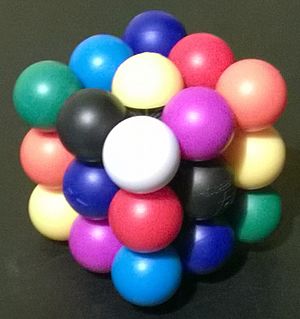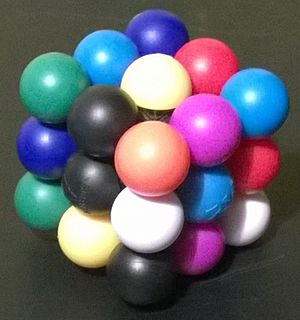Nine-Colour Cube facts for kids
The Nine-Colour Cube is a fun cube-shaped twisty puzzle. It's a bit like the famous Rubik's Cube. Milan Vodicka invented it in 2005. Seven years later, a company called Meffert's started making them for everyone to buy.
While a Rubik's Cube has 6 different colors, the Nine-Colour Cube has 9 colors. Each small piece on the puzzle has only one color.
Contents
What's in a Name?
This puzzle has been called by a few different names over time. When Milan Vodicka first invented it, he called it the "Nine-Colour Scramble Cube". This name showed that it had nine colors and that you had to scramble it. Later, people often just called it the Nine-Colour Cube.
When Meffert's started making the puzzle, they changed the shape of the small pieces to be round, like spheres. They then called it the Ball Sudoku Cube. This was because the goal of the puzzle is similar to a Sudoku Cube, where you arrange numbers.
Later, another company, Recent Toys, sold the puzzle under the name Molecube. This name probably came from how it looks like a molecular model. You might also find a stickerless, cubic version called the Kokonotsu Pillow.
How It Works
The Nine-Colour Cube is built much like a regular Rubik's Cube. It has 6 center pieces, 12 edge pieces, and 8 corner pieces. When you twist a side, the center piece stays in place. The edge and corner pieces around it move.
But here's the main difference:
- On a standard Rubik's Cube, your goal is to make each side have only one color.
- On the Nine-Colour Cube, your goal is the opposite! You want to arrange it so that every side has all nine colors, each appearing exactly once.
The Sudoku Cube is a similar puzzle. On that one, you arrange numbers (1 to 9) so each side has every number exactly once.
Puzzle Pieces
There are 26 small pieces, called cubies, on the puzzle. The colors are spread out in an interesting way:
- One color (like green in the picture) only appears on 2 pieces. Both of these are corner pieces.
- The other eight colors each appear on 3 pieces.
- Some colors are only on edge pieces.
- Other colors are on a mix of corner, edge, and center pieces.
How Many Ways Can It Be Mixed Up?
This puzzle can be mixed up in a huge number of ways! There are 8 corner pieces and 12 edge pieces that can be moved around. The center pieces stay in their spots.
Since each small piece has only one color, you can't tell if a piece is turned a certain way. This makes it a bit simpler than a Rubik's Cube in some ways.
Because some pieces have the same color, they can be swapped without changing how the puzzle looks. For example, the two green corner pieces are identical. This means the total number of unique ways to scramble the puzzle is less than you might think.
The total number of different ways to scramble the Nine-Colour Cube is: 268,240,896,000
That's over 268 billion different ways!
Finding the Solutions
Even though there are billions of ways to scramble the puzzle, there are only 80 ways to solve it! These 80 solutions can be grouped into three main types based on how the colors are arranged:
- Type 1: Most Symmetrical Solutions
* There are 8 solutions like this. * The two corner pieces of the same color are always on opposite sides of the cube. * The colors that are only on edge pieces form a cool hexagonal (six-sided) ring around the cube. * Other colors line up on diagonal planes that also include the two similar corners.
- Type 2: Slightly Less Symmetrical Solutions
* There are 24 solutions in this group. * The two same-colored corner pieces are still opposite each other. * The edge-only colors still form a hexagonal ring, but some parts of the ring might be next to the two corners. * The planes for other colors might not line up perfectly with the corners.
- Type 3: Least Symmetrical Solutions
* This is the most common type, with 48 solutions. * The edge-only colors don't form a full ring. Instead, they form two "semi-rings" that are opposite and at right angles to each other. * The colors don't always line up on the same planes, making these solutions look less orderly.



